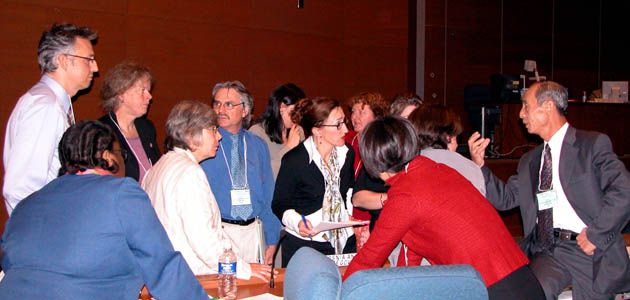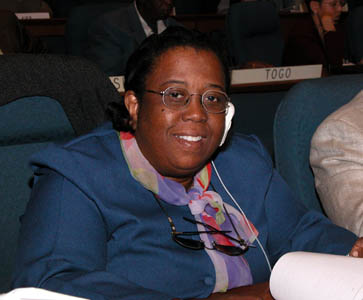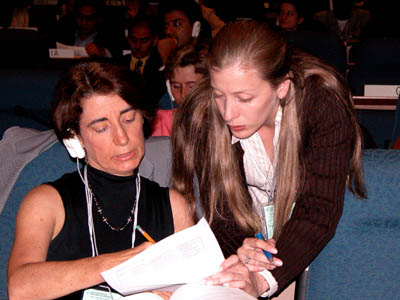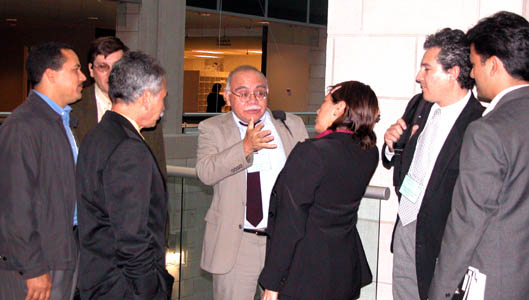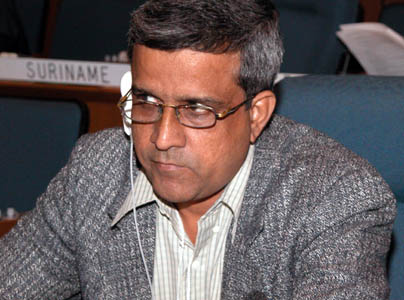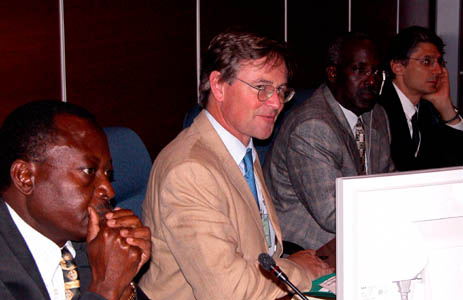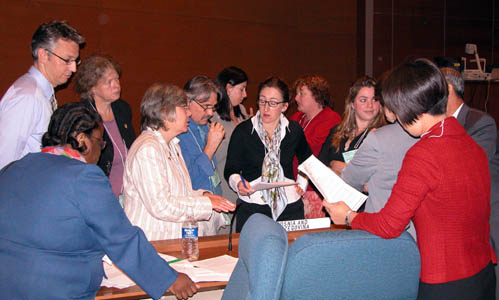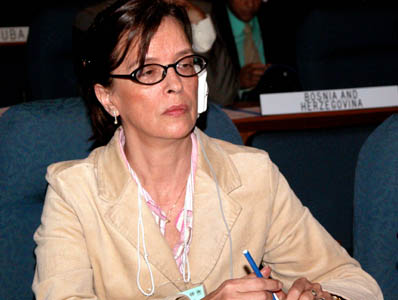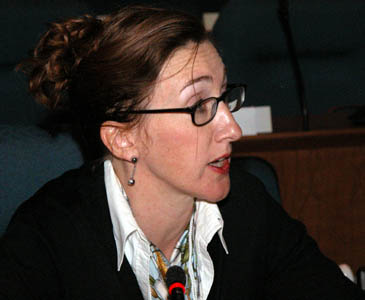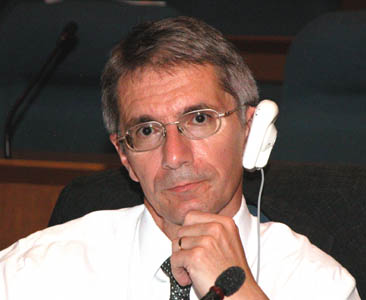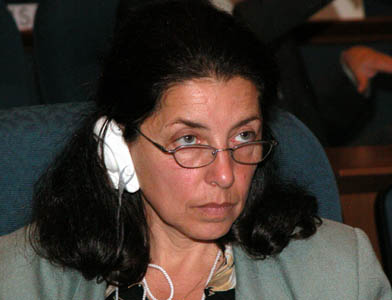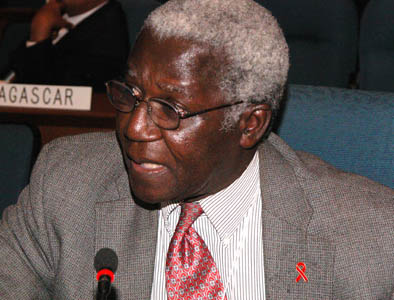|
|
|
|
Sub-Working
Group I:
|
|
Communication,
education and public awareness
:
In the morning, SWG-I addressed a CRP on
communication, education and public awareness (CEPA).
|
|
|
|
|
|

|

|
|
|
|
Canada suggested, and delegates agreed to:
provide Parties with further opportunity to comment on the
CEPA plan of implementation, before forwarding it to COP-8
for in-depth consideration and adoption; invite GEF and
Parties to make available the necessary financial
resources to implement the identified CEPA priority
activities at the national level in support of NBSAPs; and
refer to the MA in the list of global initiatives
relevant to CEPA work, with which linkages should be
explored. The EU suggested, and delegates agreed to,
inserting “potential” priority activities and developing a “short” list of priority activities in
the CEPA programme of work, to serve as the focus for the
implementation of the initiative. Delegates also agreed
to: ensure synergies and avoid duplication with respect to
cooperation with other Rio Conventions, as proposed by Brazil and the EU; and refer to the need for
changes in attitude and behavior to enhance CEPA
implementation, as requested by Saint Lucia.
Above photos L-R: Karen Brown (Canada); Glenys
Parry and Jane Bulmer (United Kingdom speaking
on behalf of the EU)
Below photos L-R: Anita James (Saint Lucia); Marcela
Nicodemos (Brazil) in consultation with Marta
Ligia Pérez (Colombia)
|
|
|
|
|
|
Financial
resources and the financial mechanism:
|
|
|
In the afternoon, SWG-I addressed a CRP on
financial resources and the financial mechanism, with discussion
focusing on: GEF disbursement procedures, collaboration with
GEF, synergies among Conventions, and national biodiversity
priorities.
On simplifying GEF disbursement procedures,
Canada, Peru, and others, opposed by El Salvador and Kiribati, objected to language singling out financing
country-driven early action on protected areas. Delegates agreed to compromise language,
suggested by the EU, referring to action on protected areas
as an example. On collaboration with the GEF, Canada
repeatedly suggested increasing dialogue on ways to more
effectively formulate and implement guidance from the
COP and reporting the results of this dialogue to the COP-8.
Pakistan, supported by Colombia, suggested
that the GEF Chairman be invited to provide details of the
GEF Resource Allocation Framework.
|
|
|
|
|
|
|
Above photos L-R: Jorge Ernesto Quezada Dias (El
Salvador); Mario Ramos (center) discussing GEF funding
procedures with delegates from Latin America; Abdul Munaf
(Pakistan)
|
|
|
Implementation
of the Convention and Strategic Plan:
|
|
|
|
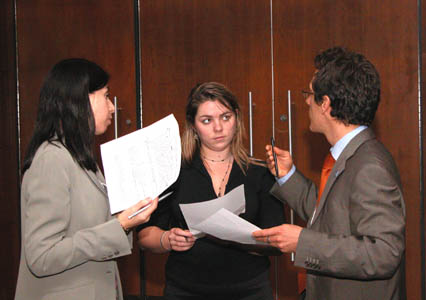
|
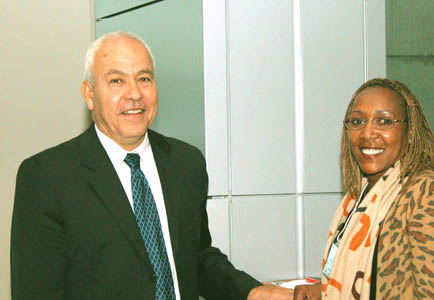
|
|
|
|
In
the afternoon, SWG-I addressed a revised CRP on
implementation of the Convention and Strategic Plan. On
preambular language on the provision of new and additional
financial resources, the EU suggested a reference to a
successful replenishment of the GEF. Canada reiterated,
and delegates agreed to, its proposal to request that the
Executive Secretary prepare for COP-8 consideration a
proposal on inviting other biodiversity-relevant
organizations, such as FAO, to participate in the
Biodiversity Liaison Group. Brazil requested recommending
that the COP decide upon concrete measures to conduct an
in-depth review of implementation of Strategic Plan Goals
2 and 3. With regard to a review of the improved status of
capacity for implementation of the Convention, Brazil
reiterated its request to review the “provision of
financial resources and capacity building and
technological cooperation” rather than the “status of
improved technical capacity.”
On
guidance for development, implementation and evaluation of
NBSAPs, Brazil requested to delete references to
mechanisms for priority setting.
Above photos L-R: Sarah Wynn-Williams (New Zealand)
in discussion with Jane Bulmer (United Kingdom) and
Matthias Buck (European Community); CBD Executive
Secretary Hamdallah Zedan with Elizabeth Migongo-Bake
(UNEP-DEWA)
|
|
|
|
|
Review
of the Convention processes:
|
|
|
|
|
|
|
Above
photos L-R: SWG-I dais with Dan Ogolla (CBD), SWG-I
Chair Jebb, Bob Kakuyo (CBD), and Marcos Silva
(CBD); Delegates
from the European Community, Norway, United Kingdom,
Switzerland, Saint Lucia, New Zealand, Australia,
Brazil and China
negotiating
language referring to the Paris Conference outcome.
|
|
SWG-I considered a CRP on the review of the Convention
processes. On reducing
workload and streamlining Convention processes, the EU proposed
that the Executive Secretary prepare options for consideration
at COP-8, including implications of changing COP periodicity.
Mexico suggested considering the amendment of current decisions
before proposing new ones, as well as maintaining a manageable
number of decisions. The
EU, Canada and Norway supported that WGRI request the Executive
Secretary and the SBSTTA Bureau to participate in the Paris
Conference initiative, stressing its relevance for the CBD's
work. Concerned with exceeding the WGRI’s mandate, New
Zealand, Brazil and Saint Lucia requested deletion of related
references, with China cautioning against additional workload
associated with such an involvement. After informal discussions,
delegates agreed that the WGRI take note of the Paris Conference
outcome and invite the Executive Secretary to report on progress
of the initiative to COP-8. On possible future meetings of the
WGRI, Australia cautioned against establishing the WGRI as a new
permanent process. On the CRP on review of processes, Chair Jebb
proposed that COP-8 consider that, subject to available
resources, WGRI meet once before COP-9. He also proposed
amending the CRP on implementation, so that COP-8 could consider
appropriate mechanisms to carry out future WGRI work, in
particular the in-depth review of Strategic goals 2 and 3. Chair
Jebb established a drafting group (photo below), which met in the
evening, to resolve issues on the modus
operandi for WGs and the list of intersessional work.
|
|
|
|
|
|
|
Sub-Working Group
II:
|
|
|
|
|
|
Cooperation
with other Conventions:
In the morning, SWG-II considered a CRP on
cooperation with other conventions, organizations
and initiatives.
On
the Global Partnership for Biodiversity (GPB), Canada,
supported by many, proposed text suggesting the Executive
Secretary undertake consultations with relevant
organizations to provide proposals for a GPB, and
emphasizing that it should, inter
alia: be a bottom-up partner-driven process;
facilitate implementation of NBSAPs; facilitate the
development of issue-based networks; and be a voluntary
alliance. Australia, supported by many, opposed deletion of text on taking into account recommendations
from SBSTTA-11 on the establishment of a liaison group on
invasive alien species, preferring a general statement on
improving cooperation with respect to the Convention’s
work on invasive alien species.
Above photos L-R: Ole Hendrickson (Canada); Annemarie
Watt (Australia)
|
|
|
|
|
|
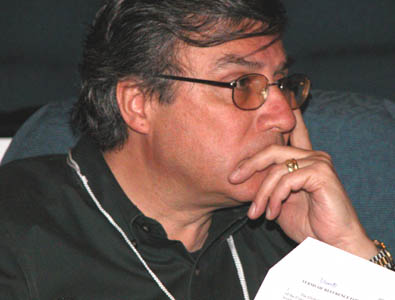
|

|
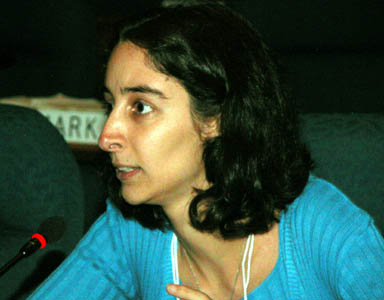
|
|
|
Above
photos L-R: Fernando Casas (Colombia); Maite
Martin-Crespo Muro and Alejandro Lago Candeira
(Spain); Adriana Tescari (Brazil)
|
|
On liaising with other conventions, Colombia requested
reference to a priority-setting mechanism for financial
and human resources needed. Brazil opposed the development
of joint work programmes. Delegates agreed on compromise
text requesting the Executive Secretary to liaise with
other conventions “with a view to advancing the
Convention implementation, in line with COP decisions,
including the possibility of developing joint work
programmes.”
|
|
|
|
|
|
|
On
cooperation between the CBD and the WTO, Argentina, Australia,
and New Zealand resisted the suggestion that the proposed
memorandum of cooperation (MOC) should promote the three
objectives of the CBD, with Australia expressing concern about
the feasibility of the endeavor. The EU and Colombia opposed,
noting the need for a stronger push forward in the cooperation
with the WTO. Delegates agreed to request the Executive Secretary to
liaise with the WTO “with a view to identify options for
closer collaboration including developing an MOC to promote the
three objectives of the Convention.”
Above photos: Victoria Lichtshein (Argentina); Jane
Coombs (New Zealand); Roy Hathaway (United Kingdom
speaking on behalf of the EU)
|
|
|
Framework
for monitoring implementation and review of work programmes:
In the afternoon, SWG-II considered a
revised CRP on the framework for monitoring implementation and
review of work programmes, with discussion focusing on the
annexed draft guidelines for the review of the work programmes.
With reference to an assessment of the adequacy of the work
programmes to address major challenges, Ghana proposed
references to MDGs and the Johannesburg Plan of Implementation.
On the steps to follow in revising and updating work programmes,
Canada proposed, and delegates agreed, to consider, but not to
prioritize, the financial implications of activities. Following
other minor amendments, delegates adopted the CRP.
|
|
|
|
|
|
|
National reporting:
In the afternoon, SWG-II considered a revised CRP on national reporting.
Norway opposed requesting the Executive Secretary to report to the COP on the feasibility and cost of providing technical assistance on report
submissions, besides reporting on additional ways and means to facilitate timely submissions of national reports. On the annexed schedule of complementary reports on thematic programmes, Ghana requested making note of reports on cross-cutting issues. On the annexed principles and elements to be taken into account in developing guidelines for the fourth national report, Brazil opposed a suggestion that national reports facilitate harmonization of reporting by joint reporting modules with biodiversity-related Conventions and other processes. Canada, on behalf of
the Friends of the Chair, Switzerland, and the EU insisted on reducing overall reporting burdens by having information fulfill multiple reporting requirements. Delegates agreed to compromise text, stating that national reports should facilitate harmonized reporting “where possible.”
Above
photos L-R: Gunn Paulsen (Norway); Risa Smith (Canada);
Alfred Oteng-Yeboah (Ghana)
|
|
|
|
|
|
|
|
|
|
|
|
|
|
|
|
|
|
|

